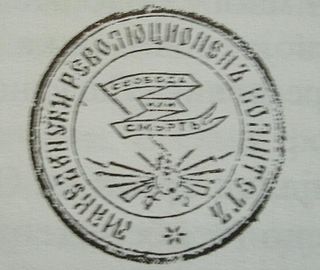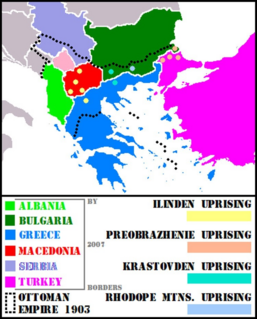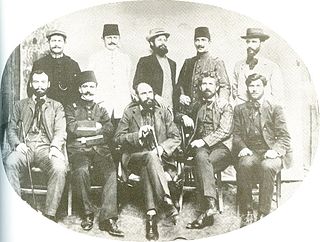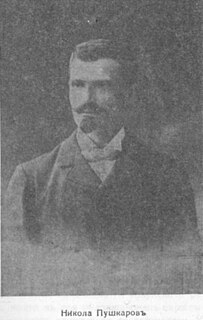
The Macedonian-Adrianople Social Democratic Group was a regional faction of the Bulgarian Workers' Social Democratic Party in the Ottoman Empire. [1] According to Macedonian historians, most of its activists were ethnic Macedonians. [2]

The Macedonian-Adrianople Social Democratic Group was a regional faction of the Bulgarian Workers' Social Democratic Party in the Ottoman Empire. [1] According to Macedonian historians, most of its activists were ethnic Macedonians. [2]
In 1894, on the instructions of Dimitar Blagoev, Vasil Glavinov founded the first socialist group in Ottoman Macedonia in Veles. In 1896 Glavinov founded the Macedonian-Adrianople Social Democratic Group itself. [3] Raising slogans such as "Macedonia for the Macedonians", and "Autonomy for Macedonia and Adrianople regions", they managed to create socialist groups and circles in some cities in Macedonia and Adrianople Thrace. They published the newspaper Political Liberty (Политическа свобода) and accepted the idea of an armed revolution, but criticized the Internal Macedonian Revolutionary Organization (IMRO) for "excessive centralization and insufficient ideological resilience." Finally the group established contacts with the IMRO and participated in the first socialist conference on July 3, 1900, held in Krushevo.
Unable to reach the mass they desired, the Socialists decided to join the IMRO, but under certain conditions: autonomy within the Organization; freedom of socialist agitation; participation by right of one of their representatives in each district committee of IMRO. [4] These conditions were accepted only by the Bitola revolutionary district, and the socialist Nikola Karev became the Krushevo district voivode and took an active part in the Ilinden Uprising in 1903. After the failure of the uprising there was discord both in the IMRO and in the BWSDP itself. After the Young Turk Revolution in 1908, the Marxist Bulgarian Social Democratic Workers' Party (Narrow Socialists) sympathized with the Bulgarian People's Federative Party and created its social democratic groups and trade unions in Macedonia and Adrianople Thrace. At the end of July 1908, Vasil Glavinov left from Bulgaria for the Ottoman Empire and toured Edirne, Alexandroupolron, Serres, Kommotini, Xanthi, Drama and settled in Thessaloniki. [5] At the end of 1910, a conference was held in Thessaloniki to establish an Ottoman Socialist Party, but attempts failed without much success.
After the beginning of the Balkan Wars (1912-1913) the members of the faction moved to Sofia, where the group was practically dissolved. [6]
At a meeting of the group on August 10, 1908, at which Dimitar Blagoev and Georgi Kirkov presented reports, the program of the group was discussed and adopted, which included demands for self-determination of the nationalities in the Ottoman Empire, general, direct, equal and secret suffrage, abolition of the Ottoman Senate, the introduction of a progressive income tax, the replacement of the regular army with a people's militia, reforms in labor legislation, and others. [7] The idea of a self-governing Macedonia (and Adrianople) regions was emphasized in the program of these socialists and their agenda was made more explicit in their newspaper Political Liberty.
The newspaper criticized the Bulgarian chauvinist government for its ambitions at territorial expansion in both areas and appealed for the creation of an independent Balkan Socialist Federation, and conceived it as some kind of “Switzerland of the Balkans”. It would have a presumed cantonal organization separate for all local national elements, which would choose free their official language. [8] Per Political Liberty, the Macedonians should not be regarded as Bulgarians, Serbs, Greeks etc., but primarily as “slaves”. Its political agenda of a separate Macedonian people was based on Marxist class-ideological aspects, with a strong anti-nationalist motivation. Such socialist rhetoric, with specific and distinct political tasks of the Macedonian people, uniting in this designation not only “Bulgarians” but a number of other “nationalities”, reveals that then socialist “national” categories were quite distinct from today's separate Macedonian and Bulgarian national concepts. [9] The idea of establishing a multinational autonomous Macedonian entity and promoting an inclusive Macedonian identity, was a supranational concept, not a national one. [10]
While Bulgarian historians today criticize such a "nihilistic" position, their Macedonian colleagues are worried that the group was blind for Macedonians' separate ethnic identity. [11]

The Internal Macedonian Revolutionary Organization was a secret revolutionary society in the Ottoman territories in Europe, that operated in the late 19th and early 20th centuries.

The Ilinden–Preobrazhenie Uprising, or simply the Ilinden Uprising of August - October 1903, was an organized revolt against the Ottoman Empire, which was prepared and carried out by the Internal Macedonian-Adrianople Revolutionary Organization, with the support of the Supreme Macedonian-Adrianople Committee. The name of the uprising refers to Ilinden, a name for Elijah's day, and to Preobrazhenie which means Transfiguration. The revolt lasted from the beginning of August to the end of October and covered a vast territory from the eastern Black Sea coast to the shores of Lake Ohrid.

Georgi Nikolov Delchev, known as Gotse Delchev or Goce Delčev, was an important Macedonian Bulgarian revolutionary (komitadji), active in the Ottoman ruled Macedonia and Adrianople regions at the turn of the 20th century. He was the most prominent leader of what is known today as Internal Macedonian Revolutionary Organization (IMRO), a secret revolutionary society, active in Ottoman territories in the Balkans, at the end of the 19th and the beginning of the 20th century. Delchev was its representative in Sofia, the capital of Principality of Bulgaria. As such he was elected also a member of the Supreme Macedonian-Adrianople Committee (SMAC), participating in the work of its governing body. Though, he was killed in a battle with an Ottoman unit on the eve of the Ilinden-Preobrazhenie uprising.

Nikola Janakiev Karev was a Macedonian Bulgarian revolutionary in Ottoman-ruled Macedonia. He was born in Kırşova and died in the village of Rayçani (Rajčani), both today in North Macedonia. Karev was a local leader of what later became known as the Internal Macedonian Revolutionary Organization (IMRO). He was also a teacher in the Bulgarian school system in his native area, and a member of the Bulgarian Workers' Social Democratic Party. Today, he is considered a hero in Bulgaria and in North Macedonia.

Yane Ivanov Sandanski, ,, was a Macedonian Bulgarian revolutionary. He is recognized as a national hero in both Bulgaria and North Macedonia.

Panko Brashnarov was a revolutionary and member of the left wing of the Internal Macedonian-Adrianople Revolutionary Organization (IMARO) and IMRO (United) later. As with many other IMARO members of the time, historians from North Macedonia consider him an ethnic Macedonian, whereas historians in Bulgaria consider him a Bulgarian. However such Macedonian activists, who came from the IMARO and the IMRO (United) never managed to get rid of their strong pro-Bulgarian bias, and continued to see themselves as Bulgarians, even in Communist Yugoslavia.

The Bulgarian People's Macedonian-Adrianople Revolutionary Organization was a short-lived Bulgarian revolutionary organization from the region of Macedonia. It was created on May 4, 1910 by members of Secret Macedonian-Adrianople Revolutionary Organization's (SMARO) Solun, Strumica and Ser revolutionary regions, excluding the supporters of Yane Sandanski. A statute and a central committee, led by Hristo Chernopeev and Anton Bozukov, were created shortly after. Some of the other more renowned members of the organization were Tane Nikolov, Apostol Petkov, Georgi Zankov and Dimitar Lyapov. After negotiations in Sofia in 1911, BPMARO united with SMARO.

The People's Federative Party was a Bulgarian political party in the Ottoman Empire, created after the Young Turk Revolution, by members of the left wing of the Internal Macedonian Adrianople Revolutionary Organization (IMARO). The party functioned for one year from August 1909 until August 1910. The Party decided to name itself Bulgarian Section, since it was hoped that other nationalities from European Turkey would adopt its program and form their own ethnic sections, but this didn't happen. Its main political rival was the Union of the Bulgarian Constitutional Clubs.

Hristo Dimitrov Uzunov was a Macedonian Bulgarian teacher and revolutionary, head of the Ohrid branch of the Internal Macedonian Revolutionary Organization and its ideological leader in the Ohrid region. Despite his Bulgarian self-identification, according to the post-WWII Macedonian historiography, he was an ethnic Macedonian.

Yordan Piperkov (1870–1903), widely known as Yordan Piperkata, was a Macedonian Bulgarian revolutionary from the early 20th century, member of the Supreme Macedonian-Adrianople Committee and later of the Internal Macedonian-Adrianople Revolutionary Organization (IMARO). According to the post-WWII Macedonian historiography, he was an ethnic Macedonian.

Vasil Stoyanov Staykov known as Vasil Adzhalarski, was a Macedonian Bulgarian revolutionary, an Internal Macedonian-Adrianople Revolutionary Organization (IMARO) leader of revolutionary bands in the regions of Skopje and Kumanovo.

Ivan Naumov, nicknamed Alyabaka or Alyabako was a Macedono-Adrianopolitan revolutionary and freedom fighter from a Bulgarian background, a member of the Internal Macedonian-Adrianople Revolutionary Organization (IMARO).

Konstantin Antonov Ivanov, nicknamed Sechenkata, and also known under the name Valcho Antonov, was a Bulgarian revolutionary, a member of the Supreme Macedonian-Adrianople Committee, the Internal Macedonian-Adrianople Revolutionary Organization (IMARO) and the Bulgarian Communist Party.

Lazar Poptraykov was a Macedonian Bulgarian revolutionary (komitadji). He was also a Bulgarian Exarchate teacher and poet from Ottoman Macedonia. He was one of the leaders of the Internal Macedonian-Adrianople Revolutionary Organization (IMARO) in the region of Kastoria (Kostur) during the Ilinden Uprising. Despite his Bulgarian identification, per post-WWII Macedonian historiography he is considered as an ethnic Macedonian.
The Macedonian Secret Revolutionary Committee(MSRC) was founded in 1895 in Plovdiv. It was developed later in Geneva in a secret, anarchistic, brotherhood called "Geneva group".
The "May Manifesto" of May 6, 1924 was a paper in which the objectives of the unified Macedonian liberation movement were presented: independence and unification of partitioned region of Macedonia, fighting all the neighbouring Balkan monarchies, supporting the Balkan Communist Federation and cooperation with the Soviet Union.

Vasil Kostov Glavinov was a Macedonian Bulgarian left-wing politician from Ottoman Macedonia, and an activist of the Bulgarian workers' movement. Per post-WWII historiography in North Macedonia he was an ethnic Macedonian.

Nikola Petkov Pushkarov (1874–1934) was the first Bulgarian soil researcher and founder of the soil science in Bulgaria. He was also an activist of the Internal Macedonian-Adrianople Revolutionary Organization.

Macedonia for the Macedonians is a political slogan used during the first half of the 20th century in the region of Macedonia.

Sotir Atanasov Yanakiev was a Bulgarian Army officer, revolutionary and voivode of the Supreme Macedonian-Adrianople Committee.